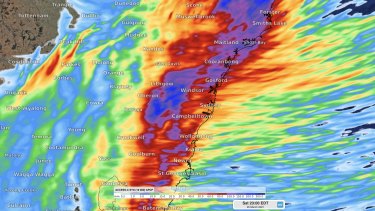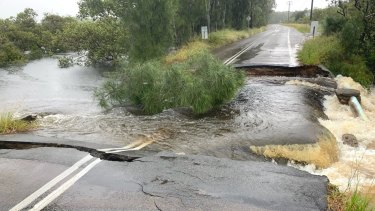-
1 of 1
Record flooding on Mid North Coast as flood warnings issued across the state
A major flood warning is in place for parts of the Mid North Coast, with flood peaks on the Hastings River and Camden Haven river exceeding previous records.
The Bureau of Meteorology said “major flood peaks” have been observed, with further rises possible due to further rainfall being forecast this weekend.
Here are the flood warnings across NSW:
- Major flooding along the Hastings River on the Mid North Coast (at Kindee Bridge, Wauchope and Settlement Point) has exceeded the levels of a record flood in 2013. The peak at Kindee Bridge was 12.1 metres at about 11pm on Friday, with major flooding ongoing
- Major flooding is occurring along the Camden Haven River at Logans Crossing on the Mid North Coast, with a second peak of 9.3 metres observed at about 2am on Saturday. Major flooding is occurring at Laurieton, exceeding the 1978 record flood level
- Major flooding is occurring along the Nambucca River at Bowraville and Macksville. Further rainfall is forecast for the remainder of today into the weekend, with further rises possible.
- Moderate flooding is possible at North Richmond, Windsor and Putty Road, north-west of Sydney, on Saturday. The catchment is “saturated” after significant rainfall for the last week, with more rain expected
- Moderate flooding is possible along the Hawkesbury and Lower Nepean River. The Hawkesbury River at North Richmond is likely to exceed the minor flood level (3.8m) around midday on Saturday, with further rises possible
- The Hawkesbury River at Windsor is likely to reach the minor flood level (5.8m) on Saturday afternoon, with further rises possible
- Minor flooding is expected at Tuggerah Lake (at Long Jetty) and Wyong on the Central Coast
Share your extreme weather stories and photos
Is your town or suburb impacted by the flooding across NSW today? Get in touch:
‘Take extreme care’: Motorists warned of low visibility from heavy rain
Motorists in all suburbs of Sydney should take “extreme care” if they venture out on Saturday, with up to 200mm of rain expected to bucket down on parts of the city in the space of 24 hours.
In an alert issued early on Saturday morning, the Bureau of Meteorology said “reduced visibility in very heavy rain will make road conditions dangerous during Saturday”.
The latest model guidance on Saturday’s rainfall in and around Sydney. The heaviest falls could occur north and west of Sydney, targeting the Blue Mountains, Central Coast and Lake Burragorang / Warragamba Dam. This model (ACCESS-C) suggests some areas could see >200mm.Credit:Weatherzone
“Motorists are advised to take extreme care,” the bureau said.
Flooding and fallen trees have already closed some roads across the state, with a landslide recorded at Dorrigo in northern NSW. In Port Stephens, flooding from persistent rain has damaged Foreshore Drive.
For the latest road closures check the Live Traffic NSW website.
Flooding damages the road at Foreshore Drive in Port Stephens.Credit:Port Stephens Council
Up to 200mm of rain expected for Sydney with evacuations, flooding on Mid North Coast
Good morning and welcome to our live coverage of the wild weather in NSW today.
Here’s what’s happened so far:
- The State Emergency Service has issued evacuation orders for low-lying properties in the Kempsey CBD, Port Macquarie, Lower Macleay and parts of the Mid North Coast, as widespread and persistent rain moves south towards Sydney
- The forecast rainfall totals in Sydney today are between 150 and 200 millimetres in Penrith and Richmond, up to 150 millimetres in Parramatta, Liverpool and Campbelltown, and up to 120 millimetres in the city and at Bondi
- The rain is expected to impact a large area between Newcastle and Kiama
- The Bureau of Meteorology says there may be periods of “intense rainfall, potentially leading to life-threatening flash flooding”
And here’s what the rain radar looks like this morning:
We’ll bring you the latest as it happens.
-
1 of 1
Most Viewed in National
Source: Read Full Article

